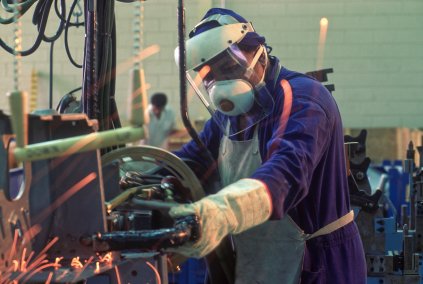
Hohenstein joins ZDHC Roadmap to Zero Programme
Hohenstein’s Dr Jan Beringer will talk about the Institute’s work to develop fabrics that make PPE apparel more resistant to molten metal hazards.

26th November 2015
Innovation in Textiles
|
Burlington, NC
Industrial workers face daily hazards but protecting those who work with molten metal is especially challenging. Hohenstein Institute is offering a webinar series, where Hohenstein’s Dr Jan Beringer will talk about the Institute’s work to develop fabrics that make PPE (personal protective equipment) apparel more resistant to molten metal hazards while still being lightweight and comfortable for workers.
The webinar, entitled Molten Danger-Protecting Workers from Welding Hazards, will be offered on Wednesday, 16 December, at 12:00 Noon EST.
Molten metal droplets can reach up to 3000â—¦ F. The typical fabric designs for protecting against such significant temperatures are thick, heavy, very tightly woven, coated cottons, which sacrifice worker comfort or flame-resistant fabrics like meta-aramids which are lighter weight but expensive.
In a joint research project with the Deutsches Textilforschungszentrum Nord-West (DTNW), Hohenstein is working to develop new PPE fabric designs that are lightweight, breathable, and flexible to maximize worker comfort and mobility, resistant to extreme temperatures, and droplet repellent to minimize the time molten metal stays in contact with the fabric’s surface. Plus, design goals include fabrics that are durable, affordable, and compliant with all regulations.
“Fabrics play a major role in protecting workers in many kinds of hazardous environments,” commented Beringer. “With today’s fabric technologies, we can apply special fibres, finishes, and even structural surfaces to more effectively handle the specific dangers molten metal poses while not compromising comfort, a critical psychological component of worker safety.”
Hohenstein’s special expertise in clothing physiology, the science of the impact clothing has on physical and mental performance, is particularly relevant in the PPE segment, the Institute reports. “While comfort isn’t always the top priority for PPE, we know from extensive study that comfort has a major influence on responsiveness, a critical factor for both worker productivity and injury avoidance,” concluded Beringer.

Business intelligence for the fibre, textiles and apparel industries: technologies, innovations, markets, investments, trade policy, sourcing, strategy...
Find out more